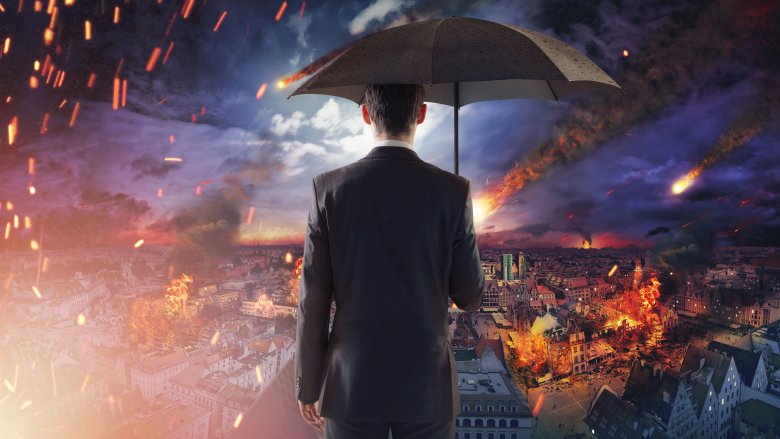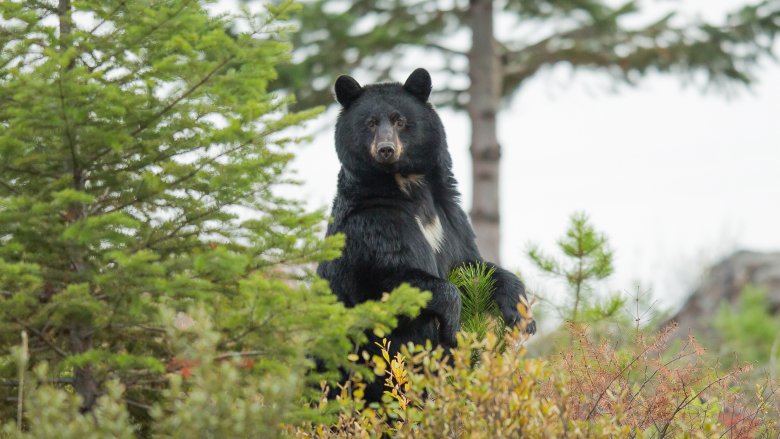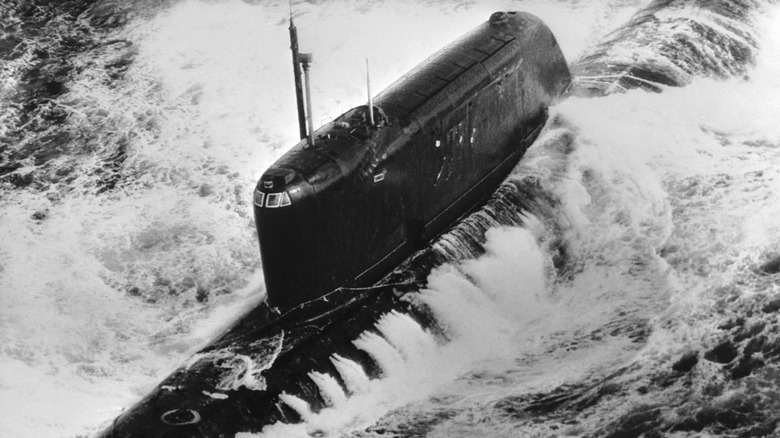Times The World Almost Ended
Let's face it. With the exception of kitten videos and the occasional pretty rainbow, the world is a pretty dark, dreary, and overall crummy place. If you've ever looked at the latest news and wondered if it was time for someone to hit the cosmic reset button, you might be slightly comforted by the fact that there's a whole bunch of times that the cosmos thought that, too. Of course, the cosmos changed its mind at the last second, but it's worth examining the few times we were dangerously close to kissing the planet — and our species — goodbye.
The Great Dying
About 250 million years ago, everyone's address was simply "Pangaea," and lizards like the awesomely-named Dinogorgon stalked the plains. But something happened at the end of this Permian era that killed about 90 percent of all species on the planet — animal, plant, and marine life alike.
When paleobiologist Cindy Looy spoke to National Geographic about the die-off, she painted a pretty grim picture. Almost all trees were gone, along with 95 percent of all species of marine animals, and more than two-thirds of land animal species. That includes the synapsids, which were what you'd get if you crossed a komodo dragon with a dog. In other words, they were pre-dinosaurs.
And no one's quite sure what happened. There's a ton of theories, including an asteroid impact, the fallout of a massive volcanic eruption, an oxygen depletion in the world's ocean, a buildup of toxic levels of CO2... who knows? We do know that the survivors — mostly fungi and pig-like creatures called Lystrosaurs — were 90 percent of the planet's species at the beginning of the 30 million years it took for earth's ecosystem to recover.
The Windscale Fire
On October 10, 1957, the world almost ended — not in a blaze of glory, but in a slow, agonizing demise. That was the day that a nuclear reactor in Cumbria, England experienced a catastrophic failure that could've been disastrous. You should thank Vic Goodwin and his crew, along with Sir John Cockcroft, for saving the future.
Goodwin was a physicist working at the Windscale nuclear reactor, and he was was the one who noticed a serious amount of radioactivity in one of the cooling chimneys. Goodwin and his crew started clearing a firebreak around the now-glowing nuclear reactors... as they watched a cloud of atomic material floating off into the northwest sky. They were ultimately assigned to make an emergency water-cooling system to try to keep the reactor from going more nuclear, and it was finally that system that put out 11 tons of burning uranium.
As for Sir John Cockcroft, he was the Atomic Energy Research Establishment director who insisted on the construction of several towers that everyone made fun of him for. They were considered by the engineers building the facility to be "pointless." They were even called Cockcroft's Follies, and they were last-minute additions to the plant that included filters for catching radioactive particles.
Of course, the ridicule stopped when everyone realized they'd captured around 95 percent of the radiation that escaped the Windscale fire, and they were the reason that Fallout is just a video game and not actual history. Even with the towers, radioactive fallout reached well into Germany, Norway, and Belgium, was responsible for hundreds of cancers and deaths.
The Minnesota Air Force Base intruder
If you didn't live through it, it's hard to imagine the terror that must have come with President John F. Kennedy's announcement regarding the threat of imminent nuclear war. The country went to DEFCON 3 on October 22, 1962. Then, on October 25, pilots at the Duluth Air National Guard Base in Minnesota were sent scrambling to their jets. Each fighter within these two squadrons was armed with a single nuclear rocket, capable of firing on and destroying any incoming Soviet bombers.
So what set things off that night? Turns out it was a bear.
It was about midnight when the guard on duty at the base saw a figure trying to climb the fence. In response, they hit the alarms, roused the pilots, and everyone was prepared to push the button and start a war. According to declassified documents and the testimony of pilot Dan Barry, he was second in line waiting to take off in his jet — which, let's reiterate, was armed with a nuke — when the whole thing was called off. Since, y'know, it was a bear, and not, say, a Soviet spy looking to hop the base's fence.
The truth about the mishap didn't come out until 25 years later, when a Stanford University professor published a book called The Limits of Safety. The book is a solemn reminder that we almost started a nuclear war because a black bear picked the worst moment to go exploring.
Stanislav Petrov
When next Thanksgiving rolls around, you should probably add Stanislav Petrov to your list of people to thank. Without him, there'd probably be no one left to celebrate, much less make your favorite apple pie.
Petrov was a lieutenant colonel in the Soviet Air Defence Forces, and he was stationed at a secret Moscow bunker. His job had only two extremes: insanely boring and insanely terrifying, because he was tasked with watching for any signs that a nuclear attack was on its way. It was his job to report signs of attack. Then, someone else would push the button that would launch a counterstrike, start World War III, and maybe even bring about nuclear winter. On September 26, 1983, he was probably wishing that things would go back to boring.
According to his early warning system, five missiles had been launched by the US and they were headed right for targets in the Soviet Union. Had Petrov followed protocol, all hell would have broken loose, and the USSR would have launched a retaliation of nukes... that would have actually been the first blow. He didn't follow protocol, all because he had a funny feeling that it was nothing more than a false alarm. He was right, and later said, "[...] they were lucky it was me on shift that night." We were all pretty lucky, as it turned out.
K-19: Hiroshima
You might have seen the movie K-19: The Widowmaker starring Harrison Ford and Liam Neeson, but the real K-19 was never called that. It was nicknamed Hiroshima, and what happened on board was nothing short of hell on earth. Even before the sub almost ended the world, construction and early voyages were plagued by bad luck and death, prompting a naval historian to write, "[...] the launching ramp of the K-19 ran with human blood."
There was such a rush to launch it that workmanship was shoddy — so shoddy that the sub and its crew were on maneuvers in 1961 when a pipe in the reactor room burst. Radiation started leaking and temperatures rose. If the sub had exploded, it would have dumped nuclear material into the waters of the North Atlantic — and that would've been catastrophic.
The captain organized a series of teams, three men each, who would go into the reactor and try to build a new cooling system. Each team worked for mere minutes before the effects of the radiation got too bad and they needed to send in the next group.
"Within two hours, we couldn't recognize them," said Captain Nikolai Zateyev, who survived the incident. "People died fully conscious, in terrible pain. [...] They begged us to kill them." All the men on the teams would die, buried in secret graves, too radioactive to be approached by friends and family. K-19 was cleaned up, put back into service, and decommissioned in 1972, after a fire killed another 28 men.
The Chicxulub impact
For a long time, it was one of science's greatest mysteries: what killed the dinosaurs? With the discovery of the Chicxulub impact crater, we finally figured it out. About 66 million years ago (probably on a Thursday, because even the dinosaurs couldn't get the hang of Thursdays), an asteroid hit the earth traveling at around 40,000 miles an hour. The impact had the equivalent effect of setting off 100 trillion tons of dynamite, and it gouged a hole a few miles deep and 115 miles wide.
Because science is much cooler than what we learned in school, it's allowed us to piece together some of the catastrophic events that happened after the impact. Thermal radiation would have roasted everything nearby, not unlike the beginning of Terminator 2, in a space of about nine seconds. Then came the tsunamis, and an earthquake that wouldn't just be off the Richter scale, it would be the same as the past 160 years' worth of earthquakes all happening at the same time.
Then there would be the debris in the air, and 600 mph winds scattering what was left of the debris... and all the roasted dinosaurs. Outside of the immediate area, predator and prey alike would have looked up to see the most staggeringly beautiful display of shooting stars ever, before everything else went dark. We're still not sure how long it took the planet to bounce back, but scientists have recovered pieces of the asteroid and are hoping to find some more answers.
Operation Able Archer
Able Archer was a war game that very nearly turned into real war. In 1983, US and NATO troops participated in an exercise that sent 40,000 soldiers marching around Western Europe using orders sent through an encrypted system. The scenario included a confrontation with Warsaw Pact countries, who had escalated into using nuclear weapons. It was all a drill, but the Soviets didn't see it that way.
According to declassified British Joint Intelligence Committee documents (and reported by The Guardian), they interpreted the Able Archer exercise as "the prelude for a nuclear strike against them." The former director of the Australian Joint Intelligence Organisation said the world was closer to all-out war in November, 1983, as a result of Able Archer than at any other time during the Cold War or Cuban Missile Crisis.
It's impossible to tell exactly how close anyone was to pushing the proverbial Big Red Button, but we do know that Soviet forces were mobilized into a state of readiness that wasn't just tasked with determining whether or not the movement of troops was a hostile one, but striking back if necessary.
The window for things to go horribly wrong was a narrow one. Able Archer was detected by Soviet intelligence on November 7, 1983, and the exercise ended on November 11. The scare ended with it, but it was close enough that NATO countries decided they better have protocols in place to make sure it didn't happen again.
The eruption of Mt. Thera
Mount Thera is a volcano on the island of Santorini, and when it erupted around 1500 BC, it not only inspired the myth of Altantis and the plagues of the Bible, but it was one of the most devastating volcanic eruptions in history. It's believed to be the event that wiped out the Island of Crete's entire Minoan civilization (and presumably the Minotaurs), and it totally derailed entire societies across the civilized world. According to an article on Live Science, people living 3,000 miles away would have heard it, but we don't have any written records of just what it was like.
A lot of what we do know, however, comes from comparing the explosion to the 1883 eruption of Krakatoa in Indonesia. According to National Geographic, Mount Thera's eruption was six times more powerful.
Live Science goes on to explain some of what researchers have figured out. We know the planet was covered with enough ash to cause darkness to fall worldwide, and tsunamis likely destroyed countless coastal settlements in what was the beating heart of the human race.
Part of the problem with determining how bad things got is that we have no idea if it was one single, catastrophic explosion, or if it happened over a period of time. Based on the devastation caused by Krakatoa, Thera's eruption would have crippled our ancestors right at the heart of their world.
Marine Isotope Stage 6
Marine Isotope Stage 6 is a boring but still vaguely threatening name for a bizarre and nearly catastrophic change in the planet's climate, which nearly wiped out all of humanity. Around 195,000 years ago, our ancient ancestors were living the good life in Africa. Unfortunately for them, the everyday climate went from, say, Spain in the summertime to Minnesota in the winter — and it stayed that way for roughly the next 70,000 years.
Most of the land that our ancestors had been living on was made completely uninhabitable, and while we obviously don't have exact numbers on just how many people survived MIS6, it's thought that there were only a few hundred.
Scientists have discovered exactly where some of them took shelter: a series of caves along the coast of the very southernmost reaches of Africa. While a mass die-off killed animals and early humans across the rest of the continent, this little pocket of survivors lived off seafood and the plants that grew along the coastline, probably in a region now called the Cape Floral Region. They managed to forage for tubers and bulbs there, gather mussels and limpets, and make some of the earliest tools we've found. Some of the earliest evidence of human cognition has been linked to these few hardy survivors, which makes your family tree way more interesting than you probably thought.
The Norwegian rocket incident
On January 25, 1995, an unlikely set of coincidences almost kick-started the End of Days.
It all started with a Norwegian experiment that was completely innocent. A group of scientists launched a rocket with the intention of gathering data on the upper atmosphere and figuring out the science behind the Aurora Borealis.
They sent out an alert, but, just like the many emails we send out today, it didn't get to the desk of the right person. When Russian radar detected the rocket, the low-res system identified it based on things like size, speed, and trajectory.
It determined that it was actually a US Trident missile, and suddenly Russia thought they were under attack. Whoops.
According to Russian protocol, the decision to retaliate against any detected attacks needed to be decided within 10 minutes. Submarine commanders, Russia's Strategic Forces, and President Boris Yeltsin were all in the loop — and the decision was made to wait. It wasn't until hours later that they found out what the rocket had really been.
While there's no official word on whether or not Norway later decided to make their research rockets look less like a Trident missile... well, it would probably be a good idea.



